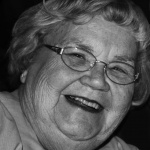By Betty Mills
Watching the young athletes of nation after nation pour into the stadium for the opening ceremony of the 2018 Olympics is to be reminded in the words of the poet Mary Oliver that “the world has meaning, beauty and holiness.” That may sound a little high-toned for some of the rough and tumble competition that followed during the games in PyeongChang last month, but it does describe the grace and unbelievable performance of the figure skaters. I am always awe-struck by the reckless and breathless athletic ability that is the heart of the quadrennial Olympics.
We spend plenty of ink to despair over wastrel youth who throw away their futures through bad habits and aimless living, so it is comforting to be visually reminded of the myriads of young people who devote their lives to becoming physically so adept at a particular sport that they qualify to compete worldwide.
Though their individual stories may differ, it’s a pretty safe bet that they had an adult support system—most often parents—who backed them with encouragement, funds, carpools; sacrificed leisure, and encouraged some pretty awesome risk-taking. At least it would invite my parental heart attack to watch a child of mine come down those mountainous slopes on skis or compete in a hockey game with potentially the world’s fiercest players. I once saw my grandson laid out cold on the ice of a local high school hockey game and cannot imagine watching such a mishap on worldwide television.
What puts a special polish on the Olympics for me is watching women compete at more than fancy skating. Since I grew up in a time and place when women were restricted as to what we could participate in, I watch today’s women athletes with a combination of joy and envy—and hunk of ancient anger.
For example, basketball for girls in my day was limited to the weekly physical education class, and we could only go as far as center court. One step on that line and the opposition got a free throw. Supposedly it had to do with not injuring our reproductive capacity but the thought of running full tilt up the court and coming to an abrupt halt at the center line makes my knees hurt in retrospect.
Perhaps the worst aspect was that we were simply not encouraged to develop our physical prowess at any sport as a part of our education whereas the boys played football, basketball, and baseball complete with equipment, coaches, and enthusiastic student support. The message was pretty easy to read—women are physically inferior and besides, competitive sports do not contribute to the proper role for women.
Perhaps there is no easier way to consider the changing expectations for women than in the matter of dress. My aunt, who was considered an expert horsewoman, sometimes rode sidesaddle the six-and-a-half miles from the ranch into town since wearing pants to ride otherwise would have been the occasion for scandal. Rumor has it that the ranch had a clay tennis court and it’s hard to believe that that same aunt would not have been playing tennis.
But wearing what?
We have a picture of my father’s family and friends taken in 1903 atop Heart Butte, the distinctive hill on the way to Lake Tschida in western North Dakota. The women are wearing long white dresses and some kind of heeled dress boots. My daughter and I climb that same butte in jeans and tennis shoes.
The world has changed, however. Slowly the world of sports opened up for women, new sports have been added to the Olympics, and this year North and South Korea participated jointly when we thought they were not even on speaking terms. Every four years when the Olympics are held we watch the nations of the world turn their attention to sports and the amazing and disciplined achievements of their young people—not with the deadly weapons of war but the fierce competition of sporting events.
Yes, there are political skirmishes, behavior disciplines, and occasionally dire threats, but none of it brings us to a world at war, and we are treated all over again to the awesome spectacle of what determined young people can do when they set a high goal like bringing home Olympic gold.
 Betty graduated with honors from Mary College in 1967 with a degree in social work. Her career has included motherhood and leader- ship; Betty served on many local boards and councils.
Betty graduated with honors from Mary College in 1967 with a degree in social work. Her career has included motherhood and leader- ship; Betty served on many local boards and councils.
